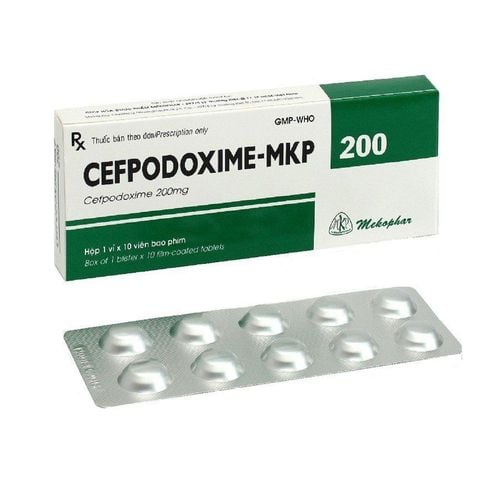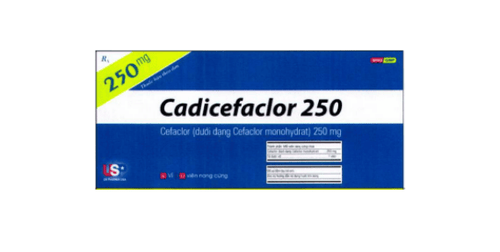This is an automatically translated article.
Cadicefaclor 250mg is manufactured and registered by US Pharma USA Co., Ltd., belongs to the group of drugs for parasites, anti-infectives, antivirals, antifungals. So what is Cadicefaclor 250mg used for and how is it used?
1. What is Cadicefaclor 250 mg?
Cadicefaclor 250 medicine has the main ingredient containing the active ingredient Cefaclor (in the form of Cefaclor monohydrate) with a concentration of 250mg, made in the form of hard capsules, packaged in boxes of 1 blister or 6 blisters, 12 tablets / 1 blister or form Bottle of 50 tablets.
2. Effects of the drug Cadicefaclor 250mg
Effect: Active ingredient Cefaclor is a bactericidal drug that works by inhibiting bacterial cell wall synthesis, so under the effect of osmotic pressure bacteria cannot create cell wall and will break. out. The outstanding advantage of Cefaclor is that it is stable to bacterial beta-lactamases and has a strong effect on Gram-negative bacteria, thereby avoiding drug resistance.
Cadicefaclor 250 is indicated for use in the following cases:
Indicated for the treatment of infections caused by susceptible bacteria: respiratory tract infections including tonsillitis and pharyngitis, otitis media , acute and chronic urinary tract infections including cystitis and pyelonephritis , sinusitis , gonococcal urethritis , skin and soft tissue infections , lower respiratory tract infections including bronchitis , pneumonia, exacerbation of chronic bronchitis. Cadicefaclor 250 is not contraindicated in the following subjects:
Contraindicated in patients with a history of hypersensitivity to beta-lactam antibiotics, cephalosporin antibiotics or to any of the excipients contained in the drug Cadicefaclor. Do not use for children < 1 month old. Contraindications of Cadicefaclor 250 must be understood as absolute contraindications, not for any reason that contraindicated subjects can use the drug.
3. Usage and dosage of Cadicefaclor 250mg
3.1. How to take Cadicefaclor 250mg Cadicefaclor drug is manufactured in the form of hard capsules, patients need to take the whole pill, and should take it on an empty stomach.
3.2. Dosage of Cadicefaclor 250mg Subjects are adults:
Usual dose: 250mg every 8 hours. In bronchitis and pneumonia: 3 times a day with a dose of 250mg / time. In sinusitis: used 3 times a day with a dose of 250mg / time, used for 10 days. For infections caused by other less susceptible organisms or more severe infections, the dose should be doubled. Do not exceed 4 grams per day. In acute gonococcal urethritis in both men and women: use a single dose of 3 grams, combined with 1 gram of Probenecid. For children:
Usual dose: Divide and use every 8 hours for a total dose of 20mg/kg body weight/day. For more serious infections, double the dose and divide it into divided doses. Do not exceed the maximum dose of 1 gram/day. In pneumonia and bronchitis: 3 times a day at a dose of 20mg/kg body weight/day. Cadicefaclor can be used in patients with renal impairment and no dose adjustment is required.
4. Undesirable effects
When using Cadicefaclor 250, in addition to the therapeutic effects, patients may also experience the following undesirable effects:
Common side effects such as diarrhea, eosinophilia, rash measles form.
Uncommon side effects such as: neutropenia, leukopenia, lymphocytosis, urticaria, pruritus, vaginitis, genital pruritus, candidiasis, positive direct coombs test.
Rare side effects: fever, anaphylaxis, serum sickness-like symptoms (inflammation or arthralgia, erythema multiforme, fever or not, proteinuria, possibly with lymphadenopathy) L. yell syndrome, Stevens-Johnson syndrome, generalized pustular rash, hemolytic anemia, thrombocytopenia, pseudomembranous colitis, hepatitis, elevated liver enzymes, cholestatic jaundice, mild elevation of serum creatinine or blood urea, Urinalysis abnormal, reversible interstitial nephritis, headache, dizziness, somnolence, insomnia, restlessness, hallucinations, confusion, hyper agitation, hypertonia, arthralgia.
Side effects may disappear when the drug is stopped, but it is recommended that patients contact their doctor immediately if they experience any unwanted symptoms for timely treatment.
5. Drug interactions
When Cadicefaclor is used together with Probenecid, it is possible to increase the concentration of cefaclor in the serum. Nephrotoxicity may be increased when Cadicefaclor is co-administered with Furosemide and Aminoglycoside diuretics. Co-administration of Cadicefaclor with antacids containing magnesium hydroxide or aluminum hydroxide group within 1 hour may reduce the absorption of Cefaclor. Cadicefaclor can cause prolongation of blood clotting time and bleeding, caution should be exercised when used with anticoagulants.
6. Notes when using Cadicefaclor 250 mg
For subjects who are pregnant women, nursing mothers, the elderly, children < 15 years old, patients with kidney failure, liver failure or a history of hypersensitivity to any ingredient of the drug. including Cefaclor or excipients, subjects with hepatic coma, myasthenia gravis, peptic ulcer need to be cautious before having indications to use Cadicefaclor 250. Patients with a history of gastrointestinal disease, especially colitis, long-term use of Cadicefaclor may cause pseudomembranous colitis. It is recommended that drivers and operators of machinery be aware of the risk of hallucinations, dizziness, and somnolence when taking the drug.
7. Storage of Cadicefaclor 250 mg
Store Cadicefaclor 250 in a cool, dry place, avoid direct sunlight exposure, the appropriate storage temperature is from 25 to below 30oC. Keep out of reach of children and pets.Please dial HOTLINE for more information or register for an appointment HERE. Download MyVinmec app to make appointments faster and to manage your bookings easily.













